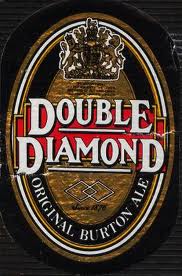Next week @ NHB will be the first brew I've done since I had the surgery. And in honor of it I decided I wanted to do a clone of one of the first non-bmc/imported beers I ever had, Double Diamond Burton Ale.

Back in 1986, when I just turned 21 I found this and Guiness around my college campus. In fact my then gf, another classmate and I would get some and pull all nighters in the radio production class studio. (Some of us who worked on campus, and were also in college radio had master keys to a lot of the buildings, so we could get away with this.)
If you've never heard of it or never had it, it was a mild/pale ale brewed in Burton on Trent, from like 1876 until about 2003.
It's hard to remember the flavor, but some discussions online mention that it is somewhat sulphury (it is Burton on Trent water afterall.)
Some info from Shut up about Barclay Perkins.
Double Diamond Pale Ale
OG 1043.8
FG 1008.1
SRM 20
Now the problem is, I've got several recipes, including one from here, and I don't know which is closest. And it's also been more than 20 years probably since I've tasted DD. So I'm wondering if any of you have some insight.
Usually when I'm clonning I pull different recipes I overlap the similarities, the sort of look at the differences. But usually I have the original to taste and help refine. But I'm working kind of blind here.
So I'd appreciate any help.
This is Starfishe's recipe from on here back in 2009.

Back in 1986, when I just turned 21 I found this and Guiness around my college campus. In fact my then gf, another classmate and I would get some and pull all nighters in the radio production class studio. (Some of us who worked on campus, and were also in college radio had master keys to a lot of the buildings, so we could get away with this.)
If you've never heard of it or never had it, it was a mild/pale ale brewed in Burton on Trent, from like 1876 until about 2003.
It's hard to remember the flavor, but some discussions online mention that it is somewhat sulphury (it is Burton on Trent water afterall.)
Some info from Shut up about Barclay Perkins.
Double Diamond Pale Ale
OG 1043.8
FG 1008.1
SRM 20
Now the problem is, I've got several recipes, including one from here, and I don't know which is closest. And it's also been more than 20 years probably since I've tasted DD. So I'm wondering if any of you have some insight.
Usually when I'm clonning I pull different recipes I overlap the similarities, the sort of look at the differences. But usually I have the original to taste and help refine. But I'm working kind of blind here.
So I'd appreciate any help.
This is Starfishe's recipe from on here back in 2009.
Double Diamond (Cats Meow post all grain)
Classification: pale ale, all-grain,
DoubleDiamondSource: Brian Glendenning([email protected]) Issue #581,2/14/91
My notes say that it was close in flavour but a bit light in both colour and body com-pared to the real thing.
Ingredients:
9 pounds, Pale ale malt
1 pound, crystal malt
3/4 pound, Brown sugar
1/2 pound, malto-dextrins ( or 3/4# carapils)
2 ounces, Williamette (60m)
1/2 ounce, Williamette
Whitbred dry yeast
Procedure:
This is an infusion mash at 156 degrees.
Sparge, and add brown sugar, and malto-dextrins.
Bring to boil and add 2 ounces Williamette hops. After 60 minutes,
turnoff heat and steep 1/2 ounce Williamettehops for 10-15 minutes.
Specifics:O.G.: 1.051F.G.: 1.010










![Craft A Brew - Safale BE-256 Yeast - Fermentis - Belgian Ale Dry Yeast - For Belgian & Strong Ales - Ingredients for Home Brewing - Beer Making Supplies - [3 Pack]](https://m.media-amazon.com/images/I/51bcKEwQmWL._SL500_.jpg)




































